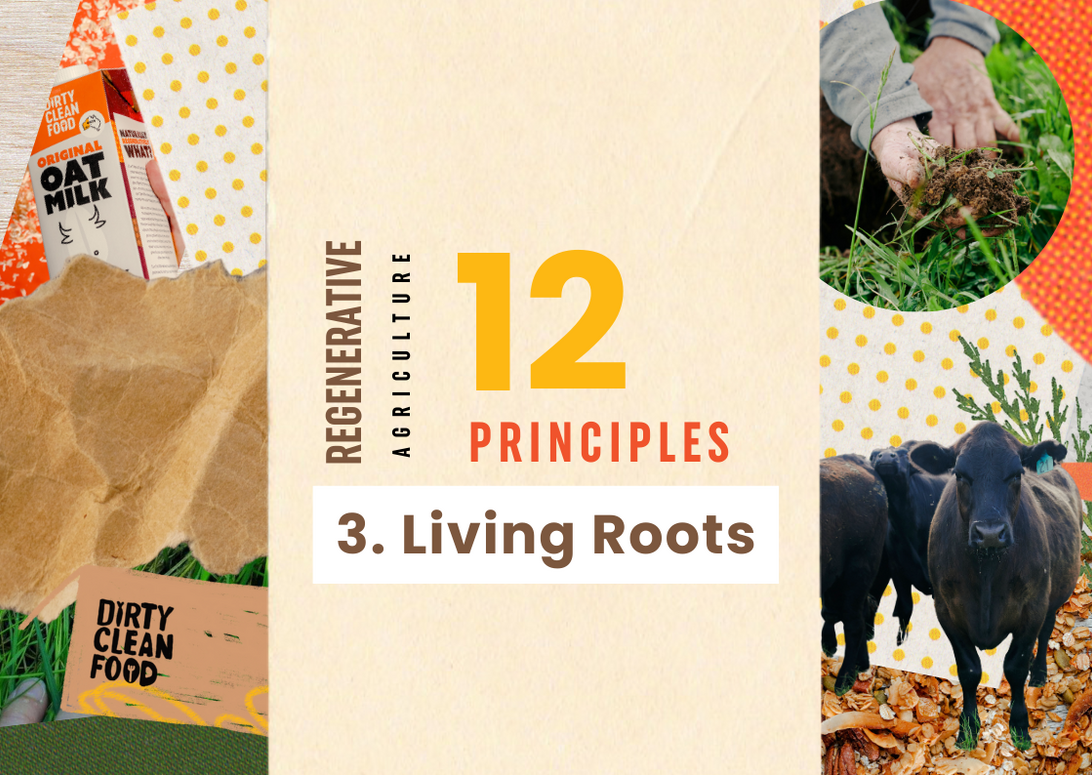
Regen Ag #3- Maintaining Living Roots, Year Round
|
Time to read 4 min
|
Time to read 4 min
Welcome to our 12 Principles of Regenerative Agriculture series- where we define "regen ag" and show you how regenerative farming changes the planet, the system, and our food.
Keeping living roots in the soil year-round can be quite a challenge in an environment like ours in the South West of WA, where most of our rain falls during winter and spring. Keeping plants alive and growing during our hot and dry summer and autumn seasons can seem a daunting task at best.
Why would we want to do this? Why try and grow plants in an environment that they won’t thrive in? The answer, like most answers in the regenerative space, starts with the soil.
Soil isn’t just dirt – healthy soil is an entire ecosystem made up of sand and clay particles, humus (decaying organic matter), microbes, bacteria, fungi, invertebrates, and worms. It is a living breathing relationship between organisms.
To understand why we want plants growing in our soil year-round, you need to understand what living plant roots mean to the soil. In a biologically active soil, the plant roots have a special relationship with microbes, bacteria and fungi in the soil. Living roots actually feed the microorganisms at the base of the soil food web.
Let’s look specifically at fungi. Plants and fungi have a very close relationship, where plant roots exude ‘exudates’, which are excess sugars generated by the plant photosynthesizing. This is also known as liquid carbon! The exudates feed the microbes living on the mycorrhizae, the underground network of fungal hyphae. The microbes in turn break down minerals and make them available to the plants, transporting them back along their hyphae highways to the plant roots. The presence of fungi and microbes in the soil actually extends the access plant roots have to nutrients and water, bringing these resources back to the plant from beyond the reach of the roots alone.
In order for the microbes to keep doing their work in the soil, they need living roots to live on and feed from!
This is a challenge for many of our farmers in WA, as living roots year round require water year round. To work with our natural systems, our farmers use approaches such as establishing perennial pastures, using opportunistic summer cover crops, creating permanent plantings, and growing summer active annuals.
On our south coast, our lamb and beef suppliers Col Bowey and Kent Rochester are focusing on establishing perennial pastures in amongst their annuals. The south coast has a higher occurrence of summer rainfall, so plants like chicory, plantain and lucerne, which are all deep rooted perennials, form a great perennial pasture base. These plants can keep growing through summer with irrigation, or go dormant when it gets dry, then back into growth with a summer thunderstorm or the first of the autumn rains.
Further north, our wheatbelt farmers take advantage of summer thunderstorms to tend the time they have living roots in the soil. Steve Ford and Jamie Anderson do this by planting opportunistic summer cover crops, such as a mix of sunflowers, millet and maize. The roots from these plants will keep pumping those exudates down into the soil, feeding those microbes for a few extra weeks. These crops aren’t usually harvested, as not enough rain will fall for the plants to grow to a viable harvest, so sheep are used to graze the plants at the end of their growing cycle.
Permanent plantings are another great way to keep those microbe communities happy. These can include pollinator strips, perennial shrub pastures, and biodiversity plantings. On Jamie Anderson, Warren Pensini and Stuart McAlpine’s farms, this is one of the many benefits they are deriving from the Dirty Clean Food Regenerative Farmer Tree Project. These permanent plantings of trees and shrubs provide habitat for all creatures great and small, both above and below the ground. Because these trees are endemic to each farm, they are actively growing year round, with their roots providing that habitat and food for soil microbes.
For Brad Campbell, our chickpea farmer down near Esperance, their spring and summer rainfall means he can grow summer active annuals such as sunflowers. Sunflowers are such a great crop for the soil.
These plants can actually improve phosphorus availability in the soil! The fungi living on and around the roots of sunflower plants take mineral phosphorus (which plants can’t absorb) and transform it into a plant-available phosphorus that plants can take up. You can see this relationship on the roots of healthy plants that have a good mycorrhizal association - it looks like a head of dreadlocks, with the soil particles clinging to the exudates on the fungi around the roots.
We hope you’ve enjoyed learning more about what it means to be a Dirty Clean Food regenerative farmer, and we look forward to showing you more in our next feature on 'Principle 4: Feed the Soil'.
‘Regenerative agriculture is an ecological approach to farming that allows landscapes to renew themselves.’





